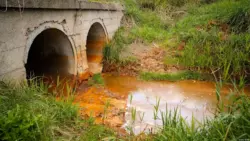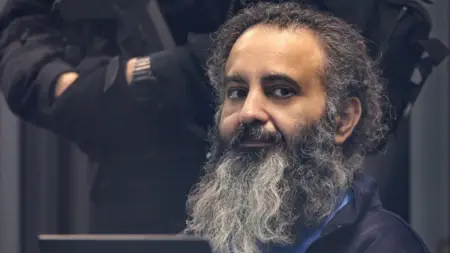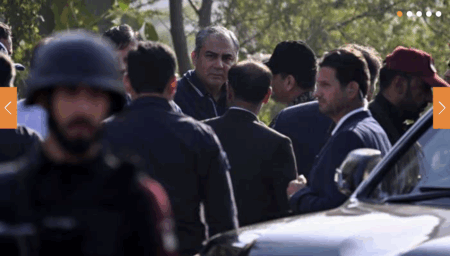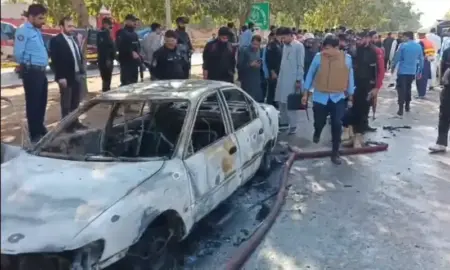TL;DR – A joint Polish and German effort to protect the Oder River
- The 2022 ecological disaster on the Oder River, triggered by pollution and high temperatures, catalysed cross-border cooperation between German and Polish environmentalists.
- The Oder River forms a natural border between Germany and Poland
- Following the mass fish die-off, initiatives like “Save the Oder” emerged, highlighting ongoing issues of saline discharge from mining operations in Poland.
- Recent successes include a petition for the river’s legal personhood and collaborative efforts that foster trilateral environmental activism among Poland, Germany, and Czechia.
German, Polish eco-activists fight to protect the Oder River
Stefanie and Norbert Bartel’s farm in eastern Germany is a stone’s throw from the Oder River and right across from the Polish town of Porzecze on the opposite riverbank.
The Oder’s lush, fertile banks attract tourists, who cycle along the broad pathways and enjoy the rich birdlife.
For the Bartels, whose farm doubles as a bed and breakfast, connecting people with nature is a personal mission.
Their farm has become a hub for local environmentalists who are united by one goal: to keep this river paradise intact.
The 2022 Oder ecological disaster
But the Oder they so love faces many challenges linked to canalization of the river and a changing climate: Sudden heavy rainfall means that the Oder regularly breaches its banks, causing flooding.
Conversely, in periods of prolonged heat, water levels can fall sharply, threatening farmers, shipping and wildlife.
In the summer of 2022, the river suffered its greatest ecological disaster in decades: a mass fish die-off triggered by upstream pollution.
At the time, the Bartels and fisher people, locals and activists on both sides of the border rolled up their sleeves and shoveled about 360 tons of dead fish and other creatures out of the water.
Scientists later traced the disaster to a toxic bloom of golden algae that thrives in the mining sector’s warm, saline discharge and is exacerbated by low water levels and high temperatures.
From disaster to cooperation
The 2022 Oder River crisis — and the authorities’ relative inaction in response to it — sparked crossborder cooperation.
“We didn’t have a lot of contact with the Polish side, but with the die-off, we got to know one another,” recalls Norbert Bartel.
The Bartels are members of Save the Oder, one of 26 local environmental initiatives in Germany, Poland and Czechia (where the Oder originates) united in the alliance known as Time for the Oder.
The alliance was launched after the severe floods of 1997 to strengthen crossborder cooperation between local actors.
The environmental disaster in 2022 was a reminder to all three countries that the river and its health do not stop at the border — and neither should responsibility for them.
Threat from industrial discharge and sewage
German computer scientist Holger Seyfarth, also of Save the Oder, argues that the underlying causes of the 2022 disaster have not been addressed.
“Factories in Poland have been pumping saline discharge into the river for years, and farmers still use the river to dispose of their sewage,” he says.
Seyfarth is right to be worried: There is no legislation in Poland banning the discharge of saline waters or sewage into rivers, and Warsaw seems in no rush to change this.
One major omission on the part of the Polish government prior to the 2022 disaster was that it did not monitor and control the water quality in the Oder on a regular basis. Moreover, any monitoring results were not shared.
Monitoring salinity
For this reason, Seyfarth and his partner Sascha Groddeck launched a citizen-led science project that uses AI to improve transparent monitoring of the river.
In 2024, Groddeck tested a prototype saline monitoring box during a kayaking tour from Wroclaw to Berlin.
His test results confirmed high salinity downstream from the Polish copper mines KGHM in Glogow, 250 kilometers upstream from the Bartel’s residence.
In late September, experts raised the alarm that the Oder is still struggling with excessive salinity, largely attributed to saline waste from mining operations.
New data confirms that the conditions that triggered the 2022 disaster remain largely unchanged, despite increased monitoring by the authorities.
Frustration and progress
Dorota Chmielowiec-Tyszko of the Polish NGO EkoFundacja is frustrated at the fact that her country is not taking responsibility and at her compatriots’ lack of outrage. “There are so few of us that our activist work consists mostly of putting out fires where necessary,” she says.
Nevertheless, EkoFundacja has in recent decades pushed through important changes in Poland’s flood prevention system: relocating dikes, reintroducing natural retention areas and creating the country’s largest dry polder.
Recently, a joint initiative of Polish and German activist groups won a court case in Warsaw to stop the canalization of the Oder, which was already underway. But despite the court’s ruling, the canalization work continues.
“What are we supposed to do?” asks Radoslaw Gawlik, whose NGO (EKO-UNIA) forced this judicial reassessment. “Legally we’ve come to a dead end. Now it’s the government’s duty to apply this ruling.”
Limits and obstacles to cooperation
Theresa Wagner of the environmental organisation BUND in Germany — and an important voice within the Time for the Oder alliance — is aware of the problems citizen initiatives face in Poland.
In her view, the challenges are structural: “There is not a lot of funding for non-governmental environmental organizations [in Poland],” she says.
Chmielowiec-Tyszko points out that while German NGOs benefit from stronger structures, slow bureaucracy is a major obstacle for them: Taking quick action, like in Poland, is often impossible.
Stefanie Bartel highlights the limits of voluntary work: “We meet each other in workshops and exchange knowledge and ideas, but if you need to find funding for projects and to run them, you need someone who does this professionally. We all have regular jobs, too.”
Increased awareness and momentum
Despite these frustrations, crossborder cooperation has raised awareness and achieved political momentum.

A petition to grant the Oder River legal personhood in Poland was recently signed by nearly 100,000 people.
Polish lawmaker Anita Kucharczyk-Dziedzic sees this as a sign of change: “The fact that so many people signed the petition shows significant interest in a healthy river.”
Have the activists had any success?
And there are cross-border success stories, too: The EURENI project, which ran from 2021 to 2025 and was funded by Germany’s Environment Ministry to the tune of over €370,000 ($428,000), linked NGOs from Poland, Germany and Czechia, fostering trilateral cooperation that seeks to ensure a sustainable future for the Oder basin.
For Dorota Chmielowiec-Tyszko, the project’s true legacy goes beyond dialogue forums, training workshops, reports and expert conferences. It lies in the education and cross-border networking that will keep environmental activism alive long after the project’s end.
Indeed, all environmental activists stressed that raising awareness is a main focus of their work.
Since the Oder River disaster in 2022, Polish environmentalists now regularly participate in a roundtable format, discussing further protective measures with political and industrial stakeholders. This is a totally new inclusive format for Poland and a big step forward for activists.
Developments like these show that applying pressure on political actors can lead to change, but also that it requires patience and endurance. It also shows that despite obstacles, cross-border cooperation is possible and can bear fruit.






